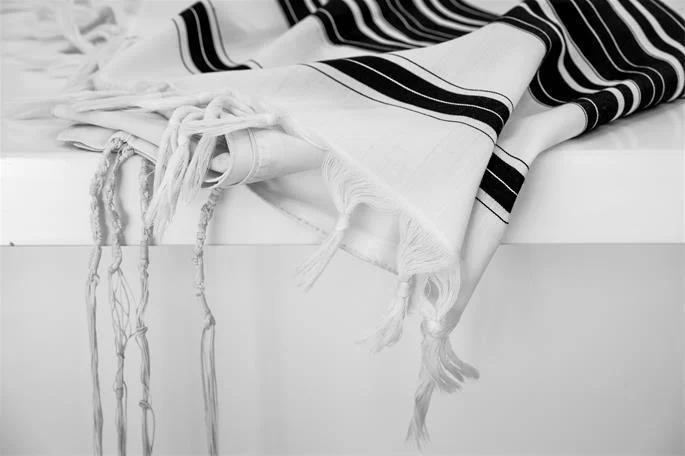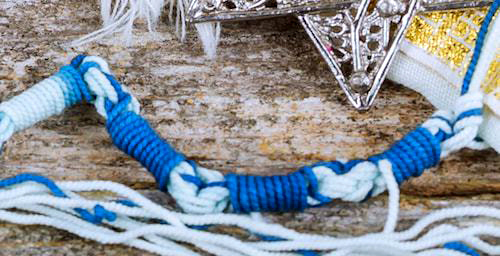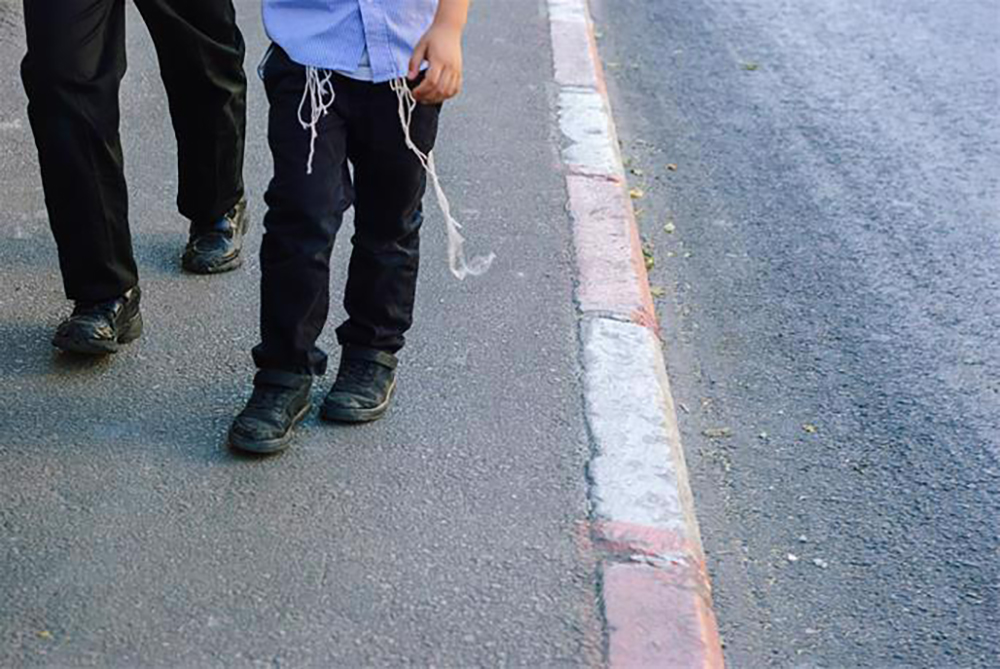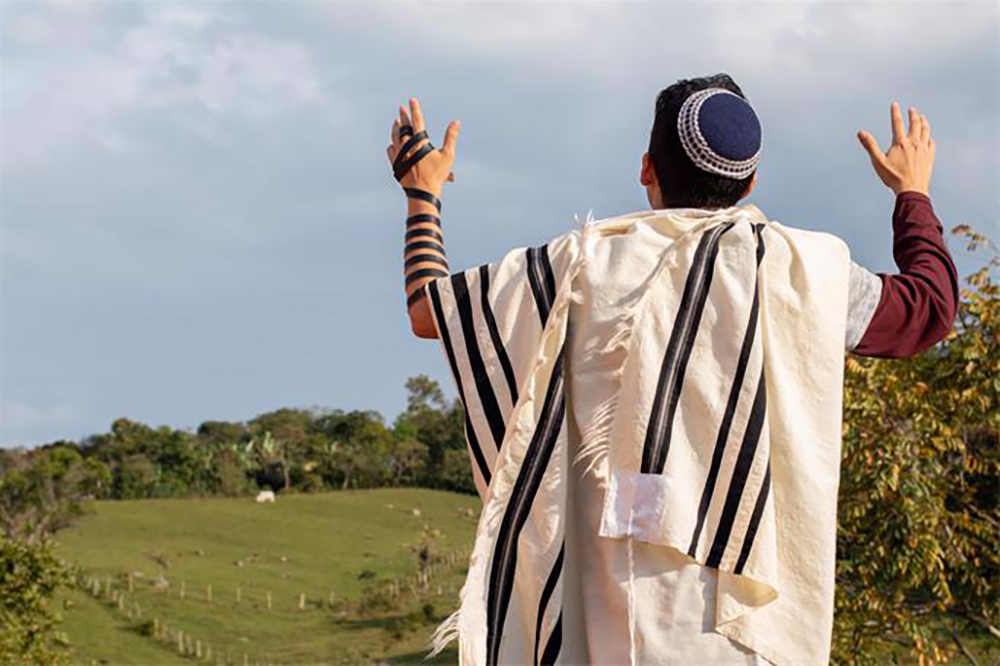|
Getting your Trinity Audio player ready...
|
By: Menachem Posner
- A Tallit Is a Four Cornered Garment
A tallit is a four-cornered sheet that was commonly used as a simple garment in the times of the Torah and the Talmud. Thus, in the Talmud, we find it mentioned in a variety of contexts, such as tossing it over an object you want to claim as your own, lending it to a buddy, sleeping under it, or finding it in the marketplace.
- It Has Fringes on Each Corner
The Torah commands us to affix fringes onto each of the four corners of our garments. Thus, when a fringed tallit is worn, the wearer fulfills a mitzvah, a Divine commandment.
- It Is Equal to the Entire Torah
We read in the Torah that we are enjoined to wear the fringes, known as tzitzit, “so that you remember and do all My commandments.” In this vein, the sages tell us that fulfilling this mitzvah is “equivalent to all the mitzvot in the Torah.”
- Each Corner Has Eight Strings
The tallit being a reflection of all the 613 commandments can be seen in the tassels themselves, each of which comprises 5 double knots and eight fringes (5+8=13). Now the Hebrew word tzitzit, ציצית, has the numeric value (gematria) of 600. 600+13=613, the exact number of mitzvot there are in the Torah.8

- The Torah Mandates Blue Fringes
The Torah tells us to place “a thread of techelet on the fringe of each corner.” Techelet is wool dyed a striking hue of blue, produced from a specific sea creature (known as the chilazon) following a particular ancient practice. In time, the identity of the chilazon as well as the dying method were lost.
The sages assert that even in the absence of blue, the white threads still constitute a valid mitzvah which we are enjoined to perform. In recent years, there have been various people who claim to have rediscovered techelet, but most Jews prefer to stick to the tried and true and do not wear the blue threads.
- It’s a Daytime Mitzvah
Since the purpose of the tzitzit is that they be seen, the sages explain that they are only required for garments worn during the day. So if you had a four-cornered pajama, would it warrant tzitzit? That’s a tricky question, since most people wear their PJs into the morning, only changing after day has begun. In addition, many specifically wish to wear a garment with tzitzit at night for spiritual protection.

- It’s Only Incumbent Upon Men
As a general rule (with several notable exceptions) any mitzvah that requires you to do something at a specific time (“time-bound positive commandment”) is only binding upon men. As such, this mitzvah, which is linked to daytime hours, is not applicable to women.
- Eastern European Jews Start Wearing It After Marriage
Sephardim and Western Ashkenazim (Yekkes) begin wearing a tallit from childhood. Among Jews of Eastern-European descent, however, the common custom is only to start wearing it from marriage, when the groom receives his tallit as a gift from the bride and her family.
- It Is Typically Worn During Morning Prayers
At one point in history, religious Jews likely wore their tallits all day long, but as fashions evolved and sheets fell out of fashion, the tallit became exclusively a ritual item, worn only during morning prayers.
- There Is a Small One Worn All Day
So what happens the rest of the day? Is the Jew to be bereft of this important reminder of G d’s wishes? Over time, a smaller, poncho-like tallit, which could be worn under a shirt, emerged. Interestingly, it is known by (at least) three names: tallit katan (small tallit), arba kanfot (four corners), and tzitzit (fringes).
And unlike the large tallit, this one is worn by even the youngest boys.
- It’s Worn All Day (and Night) on Yom Kippur
On Yom Kippur, the day of atonement, it is customary to wear the tallit for all five prayer services, even the evening service when tzitzit is not a mitzvah.
- There Is a Blessing Said
Before donning the tallit, the garment is wrapped around the upper body and a formula is said, blessing G d, “Who commanded us to enwrap with tzitzit.” Before putting on the smaller garment, which is not wrapped around the body, the blessing is modified to “who commanded us regarding the mitzvah of tzitzit.”
- White Is Most Common
Technically a tallit can be any color, and in the late Middle Ages and early modern era it was not unusual in Ashkenazi communities for people to wear tallits of other colors. Nevertheless, it is most common (and ideal) for the tallit to be (mostly) white. This is because some teach that the fringes (which are white) should be the same color of the garment.

In addition, white signifies the Kabbalistic attribute of mercy, as does the tallit, which we are told G d Himself wears while teaching Moses how to appeal for mercy.
- Wool Is Ideal
As far as mitzvah observance is concerned, only garments made of wool and linen are considered bona fide garments. Thus, this mitzvah applies only to garments made of those two materials. All other fabrics—silk, polyester, etc.—are only obligated on a rabbinic level.
Wearing woolen fringes on a linen garment could at times be a transgression of the prohibition not to wear shatnez (wool and linen together). This leaves wool as the only material with which one can practically fulfill this mitzvah in the best possible manner.
- It Is Also Called a Tallis
The final letter of the word טלית is probably most accurately as ”th,” a sound that does not exist in many languages. As such, among Sephardim it became a “t” sound, rendering the word “tallit,” while Ashkenazim pronounce it like an “s” and say “tallis.”
- Some People Prefer “Turkish”
Some Chassidic communities prefer a heavy woolen tallit made from wool from Turkey (or Tunisia, once upon a time part of the Ottoman Empire). This is apparently because flax does not grow there, and they are therefore assured that no linen was accidentally mixed into the wool.
- The Barcodes Are Not Very Important
It is traditional for the white tallit to be adorned with black or blue vertical stripes to remind us of the techelet threads once worn. The exact pattern of the stripes is purely aesthetic and has little religious significance.
- Some People Prefer an Atarah
Since the tallit is a simple rectangle, it is possible for a person to accidentally wear it upside down. To help avoid this, many (not Chabad) have a decorative strip of cloth (known as an atarah, “crown”) sewn onto the upper hem. This ornament is sometimes embroidered with the name of the tallit owner, the tallit blessing, or other texts. In some communities, the atarah is made of silver plates, which clink whenever the tallit is adjusted.
- Many Have a Special Shabbat Tallit
On Shabbat we wear fresh, dressy clothing, and many have the custom to honor the day with a special tallit reserved for the holy day (and other Jewish holidays). In addition to honoring the Shabbat, unique Shabbat garments remind us to keep the special restrictions associated with the day.18
- It’s Often Kept in a Pouch
Many men have a special pouch—typically of velvet, satin, or leather—in which the tallit is stored. This pouch is often embroidered with the owner’s name. The pouch for a weekday tallit is often large enough to hold the owner’s tefillin as well.
- The Word Tallit Does Not Appear in the Torah
Interestingly, the word tallit does not appear in the Torah even once. Rather, the terms used are beged (בגד), “garment,” and kesut (כסות), which means “cover.” The term seems to have become common in the Mishnaic (Second Temple) era.
- A Jewish Man Is Buried in His Tallit
In addition to the traditional white shrouds, a Jewish man is often wrapped in the tallit in which he prayed during his lifetime.19 To demonstrate that he is no longer obligated to fulfill the mitzvah of tzitzit, one of the fringes is typically damaged.20
In the Holy Land, the custom is that the tallit is not tampered with in any way and that it is removed before burial.
- Every Moment You Wear It Is Special
Someone who puts on a tallit (katan) once in the morning and leaves it on fulfills a mitzvah every moment that he wears it. This is because, the purpose of the tallit is to remind us of G d’s mission for us, which happens every second that this holy fringed garment is on our bodies.





